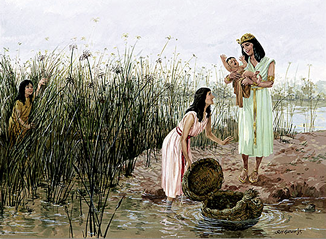
Exodus 2:1-10
A certain man of the house of Levi went and married a Levite woman. The woman conceived and bore a son; and when she saw how beautiful he was, she hid him for three months. When she could hide him no longer, she got a wicker basket for him and caulked it with bitumen and pitch. She put the child into it and placed it among the reeds by the bank of the Nile. And his sister stationed herself at a distance, to learn what would befall him. The daughter of Pharaoh came down to bathe in the Nile, while her maidens walked along the Nile. She spied the basket among the reeds and sent her slave girl to fetch it. When she opened it, she saw that it was a child, a boy crying. She took pity on it and said, “This must be a Hebrew child.” Then his sister said to Pharaoh’s daughter, “Shall I go and get you a Hebrew nurse to suckle the child for you?” And Pharaoh’s daughter answered, “Yes.” So the girl went and called the child’s mother. And Pharaoh’s daughter said to her, “Take this child and nurse it for me, and I will pay your wages.” So the woman took the child and nursed it. When the child grew up, she brought him to Pharaoh’s daughter, who made him her son. She named him Moses, explaining, “I drew him out of the water.”
Midrash
Talmudic Midrash tells of another important role for Miriam in Moses’ birth. She encouraged her parents to have more children despite Pharaoh’s cruel decree and prophesied that her mother would give birth to a son who would deliver the Hebrews from Egyptian slavery. Her parents first rejoiced when Moses when born and praised Miriam. But their joy quickly turned to sorrow when they realized that needed to give up their son to save his life. So Miriam stood by the riverbank at a distance to see whether her prophecy would be fulfilled. In addition, the Talmud connects Moses’ nursing by his mother, engineered by Miriam, with his future role as the savior of his people. [Sotah 12b-13a; Megillah 14a]
